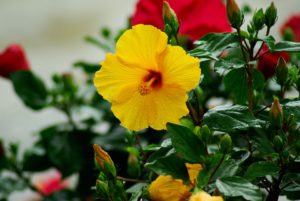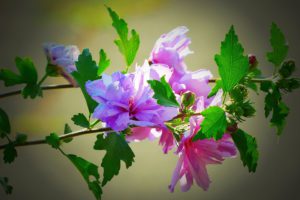Controlling Gall Midge

The hibiscus is a subtropical-tropical plant, this flowering beauty belongs to the mallow family Malvaceae. The hibiscus species are quite large, in fact, there are several hundred to choose from which produce stunning flowers that come in an array of colors. These perennials will provide your garden each year with beautiful flower bloom.
The bonus of using these plants as a part of your garden and landscape designs is hibiscus also attracts hummingbirds and butterflies and will have your garden oasis buzzing with activity. Hibiscus can grow up to as much as 15 ft, loves slightly acidic soil that is moist, loves the full sun, and prefers a fertilizer that is high in potassium to promote flower bloom.
I have used hibiscus on many garden projects to give that tropical feel and appearance, however, though these garden beauties can bring that much-needed flavor there are many garden insect pests that are considered to be a threat and quick action should be taken to bring them under control among these garden insect pests are the hibiscus mealybug, thrips, aphids, whiteflies, gnats, scales. But another garden insect pest that will also cause destruction is the hibiscus gall midge which we will be looking at more in-depth.
Hibiscus gall midge identification
If you’ve noticed the flower buds of your hibiscus turning yellow pick or remove one of these buds. Carefully open the bud and begin to inspect if you discover tiny worm-like larvae then you have hibiscus gall midge. Another test is to place the yellow buds in a clear plastic bag and sealing it properly, after several hours if it’s a midge issue they will crawl out of the flower buds. Flower buds that have fallen to the soil surface can also be tested in the same manner.
The hibiscus gall midge biology
The hibiscus gall midge is a tiny fly that lays its eggs in the flower buds, they are more active during the warmer months the larvae as we discussed earlier feeds on the flower buds before exiting and burrowing into the ground where they pupate. The pupae live in the soil that is moist for about 14-21 days before emerging to start the cycle all over again.
Hibiscus gall midge control
As we have discussed these garden insect pests are a serious threat to hibiscus and quick action must be taken before your hibiscus plant is robbed of all its buds.
1. Buds that are yellow should be picked and sealed in a plastic bag.
2. Fallen buds should be completely raked up and sealed in a plastic bag.
3. Properly dispose of the plastic bag by placing them in the trash can.
Drenching your garden soil with pesticides
As mentioned once the midge exits the flower buds they burrow in the soil to complete their life cycle before they emerge as an adult, therefore, it is of utmost importance to drench the soil around the base of your hibiscus with a pesticide that will bring them under control. The pesticides should be systemic such as Bayer Tree and Shrub or Ortho Systemic Insect Killer. What this systemic dose kills the midge while they’re in the soil.
Treating the hibiscus top growth

To ensure that the gall midge is totally eradicated apply a contact pesticide to the top of your hibiscus which includes the leaves and the buds. This treatment will kill these insects on-site as they crawl and move about on your plant or as the insects come in contact. The use of sprays such as Bayer Advanced 3-in-1 will give good results.
How does systemic work
Systemic and contact pesticides work differently, Once a systemic pesticide is applied to the soil it is absorbed by the plant, once absorbed it circulates through the plant’s system. Insects that begin feeding on the treated plant will ingest this chemical eliminating them. Systemic pesticides can also be applied to and absorb through the plant leaves and seeds.
Contact Sprays
Contact sprays can only work when it comes in contact with garden insect pests. Once the treated insect pests come in contact with these types of pesticides they will die.
The right dosage
Before using any chemicals or pesticides read and follow the directions on the manufacturer’s label for best results.
As a Bonus for You
Additional information on treating other garden insect pests that are found on hibiscus.
- Hibiscus Mealybugs
- Thrips
- Aphids
- Scales
- Whiteflies
As mentioned earlier besides the hibiscus gall midge there are other garden pests to keep a watch for which we will be discussing
How to Grow Hibiscus Plants?
Gardening -Guru
My Friend Stephen.
Stephen is a friend of mine who lives in Vietnam
He, like me, is crazy about gardening and I strongly recommend you check out his website. Here is something he has written about starting a Growing Hibiscus. And he has a lot of other blogs as well. Take the time and look at his website today. I promise you it is worth the time and effort.
For great tips on Growing the Hibiscus Plant check it out here. “How to Grow Hibiscus Plants“
Be patient you’re almost there!
Hibiscus Mealybugs
The hibiscus mealybugs are tiny white cottony insects that are covered with a mealy wax substance, these insects are among the sucking insects that suck the plant’s sap causing injury such as yellowing and browning of the leaves followed by leaf drop and also causing leaves to deform. Mealybugs are one of the more popular garden insect pests that can cause much damage to plant life. To bring mealybugs under control the use of insecticidal soap or horticultural oil has proven to give good results.
Thrips
Thrips are tiny insects that have narrow wings and are dark, the nymphs are light green or yellow and feed on hibiscus by sucking the plant’s sap. Thrips have also been known to carry and transfer viruses from plant to plant, these garden insect pests can cause great damage such as stunt the plant’s growth along with yellowing and browning of the leaves followed by leaf drop and also bud drop. Control involves the removal of infected buds from the hibiscus and buds that have fallen and resting on the soil’s surface. The use of pesticides such as Bayer Advanced 3 in 1, Multi-Insect Killer, Talstar, and Upstar is a good choice.
Aphids
Aphids are also among the sucking insect and will do the same damage as mealybugs. Aphids are tiny pear-shaped insects but there are various species which colors range from light green, brown, black, yellow, pink, white, and gray. Aphids are among the easiest garden insect pest to control.
A strong spray of water from your garden hose will knock them of garden plants eliminating them, chemicals such as horticultural oil and insecticidal soap will also bring them under control.
Scales
There are many species of scales, these garden insect pests are sucking insects that suck the plant’s sap. Scale insects are not active but remain stationary or in a fixed position but even though they are motionless they are doing damage. Insecticides such as insecticidal soap or horticultural oils will eliminate them. Releasing beneficial insects (biological control) will bring them under control also.
Whiteflies
Whiteflies are tiny white insects that dose damage as these other listed insects, another way to identify these garden insect pest is once they are disturbed will dislodge and fly quickly from the plant but will reattach just as quickly. Pesticides that will bring whiteflies under control are Insecticidal soaps, horticultural oils, or botanical insecticides.
Here are just a few hibiscus species that are available.

- Yellow Hibiscus.
- Spider Hibiscus.
- Scarlet Rosemallow.
- Cranberry Hibiscus.
- Swamp Rosemallow.
- Confederate Rose.
- Hibiscus Kokio.
- Hibiscus Boryanus.
- Hibiscus Fragilis.
- Hibiscus Genevii.
The final word on controlling gall midge
The hibiscus plant is a tropical beauty that can brighten up your garden and landscape with its cluster of flower blooms. I love hibiscus and recommended them for that tropical look as well as bringing that much-needed flavor. Keep your hibiscus healthy while producing beautiful flower blooms by eliminating the hibiscus gall midge and other garden pests that will seek to cause destruction by following these proven methods.
About the author
Norman loves being in the garden, both at home and for his job....
he is 'Natures Little helper' being outdoors, growing his vegetables and flowers from an early age.
Now having spent over 22 years in the profession he want to give some of his knowledge to others...
his vast array of hints and tips you will find scattered over this site will help you no end growing plants in your garden.

